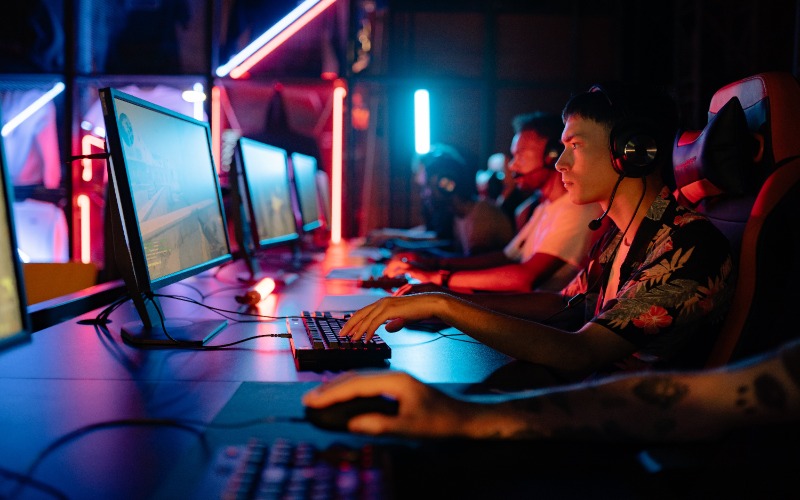In the dynamic landscape of esports, technological advancements are continually shaping how players engage with competitive gaming. One such groundbreaking innovation is the integration of Brain-Computer Interfaces (BCIs) into the realm of neurogaming. As we delve into the intersection of neuroscience and esports, this article explores how BCIs are revolutionizing competitive play, enhancing cognitive engagement, and providing new dimensions to training and skill development. Actually, neurogaming is slow, but it will indeed be transferred to related industries: even the best online casino sites 2024 are already gradually introducing various functionality onto their sites, which seemed fantastic just a few years ago.
The proliferation of esports has transformed it from a niche hobby into a global phenomenon, captivating millions of enthusiasts worldwide. As the stakes continue to rise in competitive gaming, the integration of cutting-edge technologies becomes necessary and a driving force behind the evolution of the esports landscape.
Understanding Brain-Computer Interfaces
Before delving into the impact of BCIs in esports, it’s essential to grasp the fundamentals of Brain-Computer Interfaces. BCIs are systems that establish a direct communication pathway between the brain and an external device, often a computer. By translating neural signals into actionable commands, BCIs bridge the gap between the human mind and the digital realm.
The intricate nature of BCIs involves sophisticated algorithms and sensors that decode neural patterns, allowing for a seamless connection between the player’s intentions and in-game actions. This integration introduces a level of intimacy with gaming technology that transcends traditional input methods, creating an immersive experience that aligns with the natural flow of human thought.
In the context of esports, BCIs open up unprecedented possibilities for players to interact with the virtual environment using their thoughts, offering a level of immersion previously unimaginable. This introduces a novel layer of complexity to gameplay and presents a paradigm shift in how we perceive the relationship between the human brain and gaming technology.
Enhancing Cognitive Engagement
One of the primary advantages of incorporating BCIs into esports is the heightened level of cognitive engagement they facilitate. Traditional gaming relies on physical input devices, such as keyboards, mice, or controllers, which can sometimes introduce a lag between a player’s intention and the corresponding action in the game. BCIs, on the other hand, enable players to execute commands with the speed of thought.
This instantaneous interaction fosters a more immersive and responsive gaming experience. Players can seamlessly navigate virtual worlds, execute complex strategies, and react to in-game events in real time, all driven by the power of their cognitive processes. The result is a gaming environment that is not only more challenging but also more intellectually stimulating, pushing players to sharpen their strategic thinking and decision-making skills.
The seamless integration of BCIs with existing gaming peripherals enhances the overall gaming experience, creating a synergy between traditional controls and the player’s cognitive input. This convergence accelerates the learning curve for adapting to BCIs and ensures that players can leverage the advantages of both systems for optimal performance.
Applications in Training and Skill Development
Beyond the immediate benefits during gameplay, BCIs have transformative implications for training and skill development in esports. Training regimes traditionally focus on honing motor skills, reflexes, and strategic thinking. With BCIs, players can engage in targeted mental exercises that directly translate into improved in-game performance.
BCIs offer a unique avenue for players to visualize and analyze their cognitive processes. By monitoring brain activity during gameplay, individuals can identify patterns, strengths, and areas for improvement. This data-driven approach to skill development enables personalized training programs, allowing players to enhance specific cognitive abilities crucial for success in their chosen esports discipline.
Moreover, the incorporation of BCIs in training routines extends beyond individual skill development. Teams can use collective cognitive data to analyze and optimize group dynamics, fostering better communication, coordination, and synergy among team members. This collaborative approach to skill enhancement opens up new dimensions for esports teams aiming for the pinnacle of competitive success.
Real-Time Adaptive Gameplay
BCIs not only enhance the player’s cognitive engagement but also contribute to the evolution of gameplay itself. The ability to monitor a player’s mental state in real time opens the door to adaptive gaming experiences. Games can dynamically adjust difficulty levels based on the player’s focus, stress levels, or even boredom- creating a more tailored and immersive experience.
Moreover, the potential for BCIs to integrate with virtual reality (VR) technology further expands the horizons of real-time adaptive gameplay. Imagine a scenario where the virtual environment responds not just to the player’s thoughts but also adapts to their emotional state, creating a gaming experience that is not only challenging but emotionally resonant. This emotional dimension introduces an entirely new layer of player immersion and connection with the virtual world.
Furthermore, BCIs pave the way for neurofeedback mechanisms, where players receive real-time feedback on their mental states. This self-awareness allows players to consciously regulate their cognitive processes, potentially improving performance under pressure and refining their mental resilience.
Conclusion
As we stand at the crossroads of neuroscience and esports, the integration of Brain-Computer Interfaces marks a pivotal moment in the evolution of competitive gaming. The marriage of cutting-edge technology and the intricacies of the human mind opens up new frontiers, redefining the possibilities within the esports landscape.
BCIs enhance cognitive engagement and offer a novel approach to training and skill development, pushing players to explore the untapped potential of their minds. The real-time adaptive nature of gameplay fueled by BCIs heralds a future where esports becomes not just a test of reflexes and strategy but a journey into the depths of human cognition.
As the synergy between neuroscience and esports continues to unfold, one thing becomes clear – Brain-Computer Interfaces are not just a peripheral addition to gaming; they are the gateway to a new era of competitive play, where the boundaries between the physical and virtual worlds blur, and the true potential of the human mind takes center stage.










